Galapagos islands – Part II (+ coastal Ecuador)
We’d spent a lot of time online researching the different options for Galapagos trips in the weeks before we went, and the message from the majority was to go on a multi-day cruise or don’t bother going at all. The islands are an expensive place to get to – the only real option is to fly, and the price is set at about $400 US for a return ticket from the Ecuador mainland, regardless of which airline you take. Add to this another $100 per person park entrance fee and you’re at $500 just to step foot on them. We wanted to make sure we got it right (plus we like being on boats!) so we booked a five-day cruise, even though we couldn’t really afford it at the time. The cruise was fantastic, but it turned out that the five days we spent off-board were equally as good.
After getting off our boat in Puerto Ayora and finishing our last excursion (a trip to the El Chato Tortoise Reserve in the Santa Cruz highlands), we set about on what would be one of our last accommodation searches of our trip! If you believe what most of the guidebooks tell you, staying in any of the Galapagos’ three large towns will be hard on your pocket, but this doesn’t have to be the case and with a bit of searching and bargaining, we got a lovely double room for $20 in the Hotel Espana (on the intersection of Tomas de Berlanga and Islas Plazas). Food wasn’t overpriced either – if you wanted to eat gringo-style food on Puerto Ayora’s main drag you’d pay well for it, but a trip to Charles Binford St will have you eating a set lunch of soup, main course and desert (with a drink) for $3. The restaurants on this street aren’t flashy, but you’ll be in good company (all of the locals eat here) and the food can be really good. Familiar Williams was the pick of the lot – we had the most succulent lobster in coconut sauce here for $12 on one of our last nights and it was superb (neither of us had tried lobster before and thought it was all it’s hyped up to be!). The more ordinary dishes come in huge portions and average around $3-4.
There’s plenty to keep you occupied around the town, but its highlight for me was the small fishermans port where the boats land their catch every day. The port has an army of pelicans constantly waiting for leftovers and easy thieving opportunities, but they’re not as ill behaved as you’d expect and most of them wait patiently for handouts from the fish traders. There’s even a resident sea lion who’s been hanging around for years (you can just about see his head in the picture below, underneath the womans arm).
On past the fishermans port is the Charles Darwin Research Center where Lonesome George lives. Back in the day, when the Galapagos were frequented by whalers, merchantmen and naval vessels, thousands of giant tortoises were taken away on ships as an insurance against scurvy – the huge animals could be kept alive as a future food-scource for up to eighteen months without food or water by simply turning them on their backs. This and the introduction of feral animals to the islands, all but wiped out the giant tortoise population, and while some species were wiped out altogether, many are still dangerously close to extinction. George is the last of his own species (Pinta) and was taken from Pinta island in 1971 to the Research Center where he lives to this day. They’re still trying to get him to reproduce with a close matching species and in July of this year he mated with a suitable female. However, the eggs are showing signs of being infertile but as of November, there’s still some hope that some of the thirteen eggs may hatch.
Just as with the unpopulated islands, there’s plenty of wildlife to be seen on Santa Cruz including lots of marine iguanas, boobies, finches and sally lightfoot crabs. There are some great places to visit within walking distance of Puerto Ayora like Tortuga Bay with its pristine white beach and Las Grietas gorge, a natural swimming pool filled with brackish water that’s reached by a $0.60 water taxi from the main port and a twenty minute walk.
We didn’t spend all of our time on Santa Cruz. Our cruise itinerary didn’t take in any of the northern islands, and one of them in particular that we were sorry to have missed was Bartolome island, so we went there on a day trip. It cost around $100 dollars each and was quite a long day (more than six hours were spent on the boat getting there and back) but worth it. There was a group of Japanese tourists on board who were so excited by every small animal they saw that they made us a bit more appreciative of just how much wildlife we had seen on our cruise! At one stage we spotted a huge Manta Ray swimming alongside the boat, and this, added to the Japanese group’s enthusiasm, helped pass the hours on the boat. Bartolome has some great snorkelling, an interesting lava landscape and probably the most famous vista of the Galapagos, the so-called ‘double-sided beach’.
We were really sorry to be leaving the Islands after spending ten days there, and if we were to do it again, would have stayed for another week or two at least, but our flights were booked and we had to move on.
If you’re thinking of going to the Galapagos but are put off by the cost of the cruises, my advice would be to go on out there and enjoy them from the land. You can always do a bit of island hopping when you’re there! The islands truly are a wonder of nature and they’re clearly not going to stay that way forever – we probably have less time to enjoy them than we realise.
For our remaining six days in South America we flew back to Ecuador to see a bit of the coast. During this time we visited Montanita which we disliked (too many fake hippies) and Canoa which was lovely and chilled out. We enjoyed Canoa, but really we should have just stayed in Santa Cruz as it would have been nicer and we would have avoided a lot of travelling.
After Canoa, we returned to Quito for the last time, where we ate an excellent meal in El Arabe and stayed close by in the homely and cosy Blue House. It certainly was a step up from our previous accommodation in Quito which was in the very welcoming but slighty scummy Hostel Sucre (the cheapest bed in the city I reckon at $4 for our own room). After spending our last day in the excellent Artisan’s market in Quito getting a few gifts for the folks at home, we finally left this part of America behind and flew north to New York, our last stop before returning home to Ireland.
Tags: Bartolome, Blue House Hostel, Canoa, Ecuador, El Arabe, Galapagos, Hostel Sucre, Hotel Espana, Lonesome George, Montanita, Puerto Ayora, Quito, Santa Cruz, Snorkelling, Wildlife
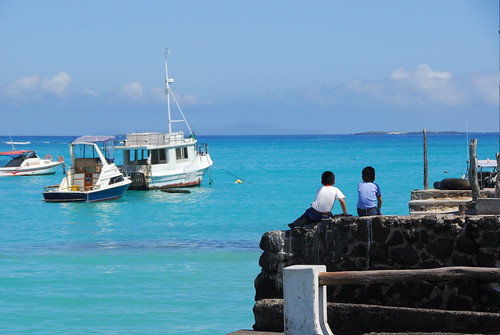
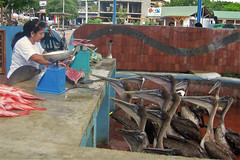

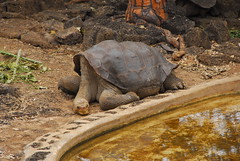
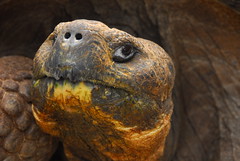
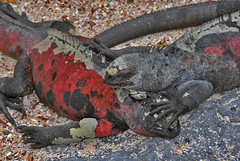
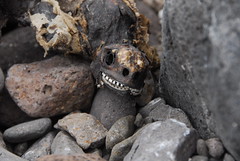
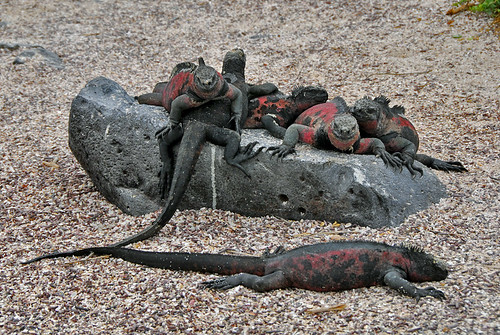
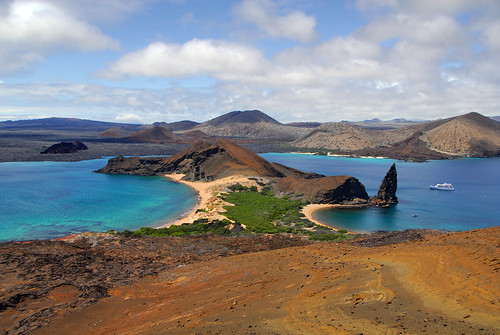
September 18th, 2009 at 9:09 am
Ah man I am pretty sure that is a wall I sat on when there. It is the greatest ost amazing place in the world and I would reccomend people beg borrow or steal the money to get there!
September 18th, 2009 at 9:21 am
100% agree, and you don’t have to go on an expensive cruise to enjoy it (although the cruises are good). Just being there is (literally) awesome :-)